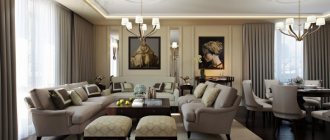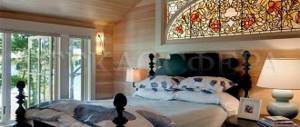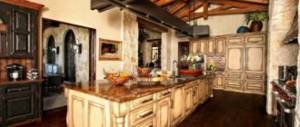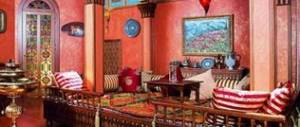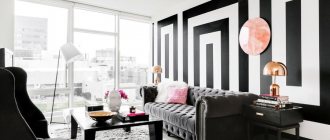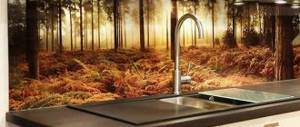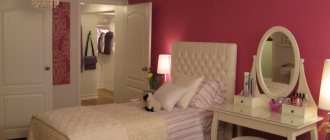Futurism , as a movement in art, arose in the twentieth century. And since then he has firmly occupied his position not only in art, but also in interior design. An owner who wants to create just such an interior for himself is a purposeful innovator who breaks all stereotypes . And, although futurism as an interior style is more suitable for office premises, recently it has begun to occupy an important place in ordinary residential apartments. This style is very suitable for young people who are passionate about new technologies, creative and energetic people.
The basis of futurism is minimalism
This is not only the basis, but also the most important and unshakable principle of this style. There is a minimal amount of furniture, and there should be no decor at all - futurism is not a decorative style. In a modern apartment, of course, it may seem unrealistic - but that’s the whole point. Breaking established traditions, completely transforming even the very idea of housing - this is the essence of futurism in the interior. After all, what is futurism? This is not just a look into the future, it is a piece of the future transferred to our reality. Science fiction at the service of modern reality!
It is minimalism that gives us such a feeling of the future . Everything should be invisible, bizarre forms that hide the true essence of things. Transformable bed, built-in furniture, pouf-tables, beds that slide into the walls, chair-beds and the like. Both rational and very unusual. This interior style is especially suitable for small spaces. During the day it is a living room in the style of a spaceship cabin, but at night it is a comfortable bedroom.
Decoration of premises
The decor in style is also expressed in novelty and perfection. It is expressed in household appliances, the latest audio and video installations, and multimedia devices.
The interior is filled with all kinds of movable mechanisms “from the future”.
We recommend watching:
- Design options for two-room apartments
- All wall finishing options
- Hygge in the interior - cozy Danish design
- Country style
- Romanesque style in the interior
Smooth lines are an essential part of futurism
For such an interior, straight walls and right angles are unacceptable; everything should be smooth and curved. This is difficult to achieve in a modern apartment - redevelopment will “eat up” a lot of space. But here truly futuristic furniture, suspended multi-level ceilings and podiums come to the rescue. This smoothes out both the evenness of the walls and the straightness of the corners. Particularly interesting in such apartments are the dedicated areas for recreation, food, etc. All these zones have smooth curves, which allows you to change the geometry of the room.
All furniture must closely match the fluidity of futurism. The chair does not have to be rectangular and have four legs - it can be in the form of a teardrop on three legs. The chairs do not have to be traditional and “stand on their feet” - they can rest on curved bolsters and be made in the form of beach loungers, or be made in the form of airplane or spaceship seats. There are simply no traditional wardrobes here - they were replaced in this style only by built-in wardrobes and hanging niches. All futuristic style furniture should only be of soft shapes - this is the basis!
Features of room design
The use of new materials in interior design is encouraged. Modern technologies must be used. Futurism is characterized by ergonomics, maximum free space and functionality. It is imperative to adhere to asymmetry. You can use multi-level ceilings of any complexity. Openings, doors, niches, windows, furniture can be chosen in interesting geometric shapes. Corners and walls should be smooth and have rounded outlines.
Related links: How to make a floor lamp into a living room decor item
Futurism theme
There are only two themes for decorating the premises - the theme of space or the theme of an apartment of the future. Not even apartments as such, but housing of the future, and a very technogenic future at that. At its core, futurism in the interior is a shock, and a well-thought-out shock. So interior design in the futurism style can be the most extravagant - a stable, a morgue, a stadium. Not in the full sense of the word, but some parts can be safely fit into the interior, and it will really be shocking.
Light in futurism.
The main point here is to implement the craziest and most extraordinary idea in such a way as to create coziness, comfort and harmony . A crazy idea, which seems crazy, is masterfully embodied in a cozy space in which it is pleasant to be in - this is the essence of interior design in the futurism style. And the most important thing about this is light! The abundance of light in the futurism style is achieved in different ways. These can be huge windows that span the entire wall. Or there may be a large amount of lighting at all levels of the room. But light in futurism is “the head of everything”!
Color of room decoration in futurism style
Only light, literally sparkling colors are inherent in this style. Metallic shades, snow-white, and matte-transparent look ideal in this style. But there are only two colors - white and black, this is a monochrome style. Bright inclusions are extremely rare, but they are in strictly dosed quantities. Here everything is created by the material and lighting!
Surfaces can be matte, glossy, reflective, but without inclusions of another color. With the right lighting, it is the combination of different surfaces that will give a feeling of saturation not only with light, but also with color. For example, a purple or blue LED cord can be attached to the side panel of a white podium with a reflective surface. And then the entire surface of the podium gradually smoothly distributes this color from dark purple in the middle to light purple towards the edges.
Adding color through lighting.
A combination of white and black colors is allowed, but black here comes either as edging or details. For the ceiling – no “chess” or other combinations, only white or steel color. Sometimes black is used as the basis for separating a certain area of the room, sometimes the floor is black, and everything else is white. Only such combinations are inherent in the futurism style in the interior.
Bedroom in futurism style
This is generally a separate topic for conversation - a bedroom in the futurism style! Here space is taken as a basis, and this space is present in everything. The ceiling, designed in the form of a starry sky, will immerse you in a world of dreams every night or take you away into the distances of the universe. A bed, made either in the form of a shuttle, or even better in the form of a cryochamber, in which you can spend many years in suspended animation, is set up in a truly cosmic mood. A mixture of steel shades and white only emphasizes the depth of the “space” ceiling. LED backlights highlight those areas that are necessary, while the rest remain “overboard”.
All cabinets and places for bedding can be successfully disguised at the base of the bed or as compartments for spacesuits. The decor in such a bedroom, as in the futurism style in general, is harmoniously located and secured wires from the TV and other household appliances. The whole point here is that in other styles all communications are carefully disguised, but in the futurism style they become real decor! The interweaving of cables and wires, harmoniously decorated along the walls, is the most important decor of futurism.
Bedside rugs can now be found specifically for this style. They are made either in the form of steel plates, or in the form of microcircuits, or in the form of hatches with ladders. And this only further emphasizes the “cosmic” nature of the futuristic bedroom. The most important thing is that in such a bedroom there is nothing in sight except a bed in a space style - everything else is successfully disguised. Just a bed and a starry sky above it! Agree, very fantastic!
The Shape of the Future: The History of Futurism in Fashion
On February 10, there will be a show of the Ukrainian brand Iva Nerolli, which addresses the theme of futurism in its collections. We decided to remember where this concept came from and which other designers were interested in this topic in their work
Beginning of the last century
Futurism appeared as an artistic movement at the beginning of the last century, found visual embodiment in cinema, from where it quickly seeped into fashion. In 1916, Italian avant-garde photographer Anton Giulio Bragaglia directed the film Thais, which is rightfully considered the first futurist cinema in history. The footage of the film was extremely surreal, through the stylized geometric scenery, the heroine of the film endures difficult experiences as punishment for ruining men. Six years earlier, one of the founders of Futurism as an artistic movement, the brothers Amaldo Ginnah and Brunno Cora, experimented with existing technologies for working with sound and color, which was embodied in short films: "The Agreement in Color", which was based on the symbolic painting of Giovanni Segantini, "A Study of the Effects of Four Colours" and a visualized translation of Stéphane Mallarmé's poem "Flowers" and Mendelssohn's "Spring Song".
In the early years, the nascent futurism was based on the cultural and artistic heritage of Italy, classicism and symbolism, and the goal of the new artists was to transform this heritage into modern, deconstructed forms, directing thoughts to the development of society in the future.
In 1917, a film created by members of the Futurist group in Florence was released, it was called “A Brief Biography of a Futurist” and consisted of several parts: “Breakfast of a Futurist”, “Sentimental Futurist”, “How a Futurist Sleeps”, “Caricature of Hamlet”, “Dance” geometric brilliance" and "Introspective research in the state of thinking." The creators screened the film by throwing tomatoes, coal and oranges at the screens. Futurist cinema for the artists of that time was a kind of joyful deformation of the universe, as the artists themselves put it.
During the heyday of cosmological fantasies and industrialization briskly marching across Europe, ideas of denial of outdated canons of symbolism and mysticism, urban philosophy and the desire to look into the cosmic future and distant unexplored worlds gained momentum in society. Periods of depression in America and the looming specter of war in Europe influenced the optimistic concepts of the futurists - for example, in 1927, the film Metropolis, directed by Fritz Lang, was created, in which events take place in a dystopian city of the future.
Later, a similar idea of gloomy futurism will be reflected in the cult films of the 80s: “Blade Runner”, “Tron” and others. The image of the robot Mary was created under the impression of artists from Egyptian statues - subsequently, all futuristic design was based on the artistic heritage of antiquity. In 2007, designer Nicolas Ghesquière dissected the Metropolis aesthetic in his spring-summer 2007 collection for the Balenciaga house.
With the development of the phenomenon, futurism penetrated the minds of many artists and was especially clearly expressed in the costumes they created. For example, in the 1920s, the artist Erneste Michaelle, known as Taiyat, created a unisex suit with a utilitarian and ultra-simple design, which, according to the author, embodied the idea of clothing of the future - emphatically simple and comfortable, with a geometric cut and minimal embellishment.
In the 1930s in Britain, William Cameron Menzies made the science-fiction and philosophical film “The Shape of Things to Come,” which largely defined sci-fi design. The film's costume style was based on ancient Roman and Greek silhouettes and artistic lines of clothing from Ancient Egypt, adapted to new ideas of form and composition. Imagining the future, people were confident that fashion would combine the classical principles of harmony and innovation.
Mid century
With the advent of various types of plastic, the position of futuristic aesthetics was strengthened. Fantastic raincoats, dresses and hats made of vinyl, unusual geometric decorations of the 30s and militarized objects in the 1940s became common attributes.
The development of functional design and industry, on the one hand, and the need to reduce excessive production costs, on the other, led to the emergence of a kind of home of the future, in which the interiors, household contents and appliances had a minimalistic and somewhat unearthly appearance.
Fashion design has also become more utilitarian. And although throughout the 40s and post-war 50s the role of a woman and the appearance of her wardrobe were determined by practical considerations, and later by the desire to restore gender harmony in a devastated society, even then couturiers and advertising artists, sensing the approach of the revolutionary 60s, created their own collections and campaigns with fantasies of the future.
Hubert de Givenchy and Cristobal Balenciaga were major fashion innovators, creating intelligent and moderately avant-garde clothing. In 1958, the television series "The Twilight Zone" was released, the author of which, Rod Serling, embodied science fiction, drama and horror in each episode, based on knowledge of the human nature of fear of the unknown gained in World War II. Despite the series' bleak subject matter, the female characters' costumes were a unique blend of eroticism, contemporary '50s elegance, and the extraterrestrial aesthetic of spaceship crew uniforms.
In literature, ideas of clothing and materials of the future were also embodied in the works of Robert Heinlein, Isaac Asimov, Stanislaw Lem, George Martin, James Ballard. Fabrics that can be sprayed onto the body, biosuits that adapt to a living organism, recyclable materials and protective transforming clothing, which the masters of science fiction wrote about in the last century, no longer seem like pure fiction. Just look at the water-washed dresses at the Hussein Chalayan spring 2020 show.
The heyday of pure futurism occurred in the 1960s and 70s - the times of space exploration, technological and economic breakthroughs. Humanity has approached the mystery of the distant and unknown and has begun to fantasize with all its might what will happen next.
Designers also echoed the optimistic mood. Andre Courrèges, Paco Rabanne, Pierre Cardin, Mary Quant were the pioneers of the new fashion. By creating collections from plastic, experimenting with shapes, geometry and cut, these designers echoed society's fantasies about clothing and images of people of the future.
Courrèges was obsessed with space, the stories of science fiction writers, and the profession of engineer. However, after completing his studies with Cristobal Balenciaga, separating from the house of Balenciaga, the designer preached the ideas of aesthetic and functional optimization of the wardrobe for life in the future, that is, the anticipation of this very future. Thanks to his fanaticism and contribution to the popularization of space ideas, he was awarded an invitation to the military base located at Cape Canaveral, from where NASA rockets were launched.
In 1968, the film “Barbarella” was released, directed by Roger Vadim and starring Jane Fonda. The costumes for Barbarella were created by Pierre Cardin - vinyl jumpsuits, dresses made of plastic and metal plates, body armor and shiny bikinis made of metallic materials amazed audiences and made the film a cult source of inspiration for all subsequent decades.
Also in 1968, the science fiction series Star Trek was released on television, which had a huge impact on popular culture, including fashion. The crew members of the spaceship Enterprise traveled beyond the galaxy, exploring new worlds and planets and getting to know their inhabitants. Star Trek fashion was bright and optimistic. The women of the crew wore ultra-short skirts, bright tops and shiny jumpsuits, and alien guests, ambassadors, kings and princesses appeared in each episode in breathtaking outfits: luxurious dresses embroidered with metal bugles and plastic, trendy boots, geometric suits and “unearthly” makeup on face. Quotes from outfits from the series can be seen in the collections of Moschino FW 2020, Alexander Wang, Balenciaga during the time of Nicolas Ghesquière and many others.
In 1970, the series “UFO” was released in Britain about an alien invasion of earth. In addition to the extravagant outfits of the characters, the image of the heroine Guy Ellis was notable - purple hair in a geometric haircut, “Egyptian” makeup and silver suits imitating spacesuits, many tried to reproduce in life. Jeremy Scott's fall/winter 2020 collection featured models wearing very similar looks: colorful cropped wigs and sparkly space suits layered over neon tops and turtlenecks.
In the 1980s and 90s, futurism became a familiar but still relevant phenomenon in cinema and fashion. For example, in the 1992 film Bodyguard, costume designer Susan Nininger dressed Whitney Houston for the scene in a suit of metal armor with a skirt and collar made of chains and beads. The minds of a bored society were again captured by dystopias - and films such as “Blade Runner”, “Mad Max”, “Tron”, “The Fifth Element”, “A Space Odyssey” and “Star Wars” appeared on the screens until the 2000s. images from which are firmly entrenched in fantasy, and quotes have spread throughout all collections, cosplay and fetish communities until today.
“Tron,” like “Metropolis,” was reflected in Balenciaga’s 2007 spring-summer collection. “Star Wars” can be seen at Vetements SS 2020, Rodarte FW 2014, Acne Studios, Balenciaga Spring 2012 and Triton - the Brazilian brand released girls dressed as stormtroopers on the catwalk in 2020. Also, luxurious and phantasmagoric alien images are a distinctive feature of the Thierry Mugler fashion house, which created unique shows in the 90s.
Nowadays, when the problem of industrial waste and environmental threats is adjacent to the progressive exploration of space, fashion cannot remain on the sidelines - and starting in 2020, the industry is heading towards sustainable development, recycling materials and collections, using new types of biologically viable fabrics and, of course, experiments with forms and retrofuturistic style.
Since NASA published data on the discovery of seven planets outside the solar system, three of which are suitable for life, interest in the topic of science fiction and science has increased. The collections of Chanel, Akris, Jean Paul Gaultier, Jil Sander and many other leading fashion houses are filled with images and clothes with a technological aesthetic. Iva Nerolli will present an autumn-winter collection dedicated to the image of the woman of the future and the search for inner harmony. The collection is built on the contrasts of black, as a desire for space and freedom, and white, as a symbol of purity. Universality is the main characteristic of the new futurism. The designer created items suitable for formal and everyday occasions. Cosmic glamor - this is how you can describe a collection of shiny dresses and transparent shoes - we'll probably be wearing similar ones when strolling through the alien cities of the future.
Kitchen in futurism style
A kitchen designed in a futuristic style always amazes with its modernity. This is either the dining compartment of a spaceship, or a real kitchen of the future. There is nothing real here, only an abundance of light, all kinds of food processors, “mechanical assistants.” There is no dining area as such in such a kitchen, just as there are no soft sofas or a dining table itself. The role of such a table is played by a semicircular table with a bar instead of a leg, placed slightly forward of the general area of the built-in equipment. On one of the walls of this kitchen there is a flat TV screen.
The washing machine and dishwasher are built flush with the rest of the furniture and form one unit with the kitchen unit. And it must be strict and laconic, without decorations or curls, and in a snow-white or metallic shade, no bright inclusions in the form of napkins or dishes.
Glasses and other utensils are hung from special holders along the wall and above a kind of counter.
Steel or white blinds replace curtains, and chairs are made in the form of stools on one leg. Moreover, usually these stools are pushed under the very counter that serves as the dining table. But they are not just pushed in, they are inserted into special holders that are located under the stand itself, and their legs hang slightly above the floor. This creates a feeling of weightlessness and a cosmic mood.
Lighting in such a kitchen is always done at different levels. There is a separate working area and a separate washing area. The ceilings are multi-tiered in order to efficiently distribute the built-in lighting, because there is no place for chandeliers and lamps in such a kitchen. The window is also framed with an LED strip to emphasize the “cosmic” feel of the room in the evening. Often the front door is framed with the same ribbon, this creates the feeling of a kind of compartment, and not just a room in the apartment.
In such a kitchen, everything is strictly functional, everything is in its place. And, most importantly, nothing lies open on the table in the area near the sink. This is a super perfect kitchen !
Bathroom in futurism style
In a futuristic style bathroom there is plenty of room to roam – this is where the abundance of white and bright, blinding lights feel especially comfortable.
The bathtub rises to the podium and its shape is absolutely insane, fortunately, now you can buy bathtubs in any form. Everything you need from accessories is hidden on the podium; nothing should be on the surface.
There are no wall cabinets, no laundry baskets - just walls, a podium, a weirdly shaped washbasin and LED lighting at different levels.
All communications - pipes, radiators, towel holders - everything is painted in steel color and serves as decor for this interior. Sometimes it is appropriate to add a few fake pipes to balance out this unique decor.
The mirrored ceiling and one of the walls add a futuristic feel to the interior. If for some reason a cabinet is still needed, it should be either a steel color in the shape of a junction box, or completely mirrored.
Only light metallic or snow-white colors become key in the design of such a bathroom. Sometimes you can include a little blue or fuchsia, but only a little and in the decoration of either the walls or the ceiling around the perimeter. The floor looks best when poured - both beautiful and as comfortable as possible. And if a mirrored ceiling inspires doubt, then a suspended one will do.
Materials for interior design in futurism style
Today there are so many things on the building materials market that have never been heard of before that it is not difficult to design a room in the futurism style. This style is characterized by the use of only modern and high-tech materials. This is laminated glass of various shades, high-strength plastic, various metallized surfaces. And LEDs and neon lamps allow you not only to zone the room, but also to visually expand it. Moreover, the latest multimedia equipment will help in a matter of seconds to change not only the intensity of lighting, but also its color.
smart home system in such a room (house, apartment), decorated in futurism style .
This is exactly the future that you want to create - machines do everything for you! This combination of interior design and high technology at all levels defines the true futurist style in the interior.
Futurism style in the interior 70+ amazing design ideas (51 photos)
Futurism in the interior is not only an original style, but also an option for the rational use of space and materials. This direction arose at the beginning of the 20th century, and today they have begun to pay more and more attention to it. Moreover, both designers and ordinary people who strive to create an original, unusual style in their home. This direction has not yet been fully promoted, and therefore requires clarification of certain important points.
Elements and features of futurism style in interior design
In futurism there are no strict requirements for the colors used. A room, apartment or entire house can be filled with both bright shades and calm, pastel ones. In the first case, the brightness will not be superfluous; in the second, the style will emphasize certain details.
On a note! Furniture should be special - flowing, fancy shapes. Transformable and block furniture is often used. It can be disassembled and reassembled in different configurations.
Advice! Designers recommend using chairs and transformable beds. Firstly, they support the style, and secondly, they save space well. The last point is very important if the room is small.
As for lighting fixtures, they are often hidden. It is most convenient to build such devices into furniture, ceilings, even floors. At the moment, manufacturers offer many options for chandeliers and lamps, which perfectly emphasizes the style in question.
Characteristic features of the futurism style in the house (photos and examples)
In order for the style to breathe futurism or at least look like it, when designing it is important to consider the following points:
- A minimum of everything. It is minimalism that can be called the basis of futurism. There should be little furniture, accessories, or decorations. This is not surprising, because this style is not decorative.
Minimalism style in the interior (23 photos)
- Multifunctionality. This applies not only to furniture, but to everything that surrounds a person in the room. A pouf can be a table at the same time, and a chair can be a bed. It’s great if the furniture can be pushed into the wall.
- Smooth lines or diamonds. Designers strongly recommend abandoning smooth walls and sharp corners. Achieving a streamlined shape can sometimes be difficult, but you need to strive for it. If everything is not so simple with finishing, then the furniture should be streamlined.
Important! Streamlined forms in furniture are perhaps the main remarkable feature of futurism.
- Theme of the future, space. This is the main direction to focus on. In any case, the style of the room, created in the spirit of futurism, is somewhat reminiscent of a spaceship or apartments of the future.
- Materials come from the future. Of course, we are not talking about any secret developments, but we still have to abandon the standard tree. Moreover, the refusal will be in favor of glass, metal, polyurethane, carbon, leather, aluminum, plastic, fiberglass and others. There should definitely be no wallpaper on the walls; instead, painting or plastic panels are used. For the floor, black laminate, tiles are used, best of all self-leveling flooring. When following style, it is important not to forget about safety and environmental friendliness.
- Gloss. Although there are no clear prohibitions on the use of one color or another, there is one important point - glossy surfaces and other reflective materials. Thanks to this technique, it will be possible to intertwine all the colors with each other and create the effect of their diversity.
- Modern technology, lighting. In this style, you need to abandon your grandmother’s lamps and even more so the ancient models of equipment. A “smart home” system would be appropriate here, when all devices can be controlled remotely.
- Decor. It can be present, only in most cases in multimedia form. The only exception is paintings in the style of cubism, futurism, and fauvism.
My house and the stairs in it (3 photos)
Important! Futurism is not always all of the above features at once; it can be easily adapted even to a standard apartment in an apartment building. Of course, the features of the style cannot be missed so that it remains recognizable.
If you decide to strictly follow the style, you need to plan rounded doorways, the absence of corners and other important architectural nuances even before the renovation begins. Of course, cosmetic repairs are not enough in this case.
Lighting and furniture in futurism style
Perhaps these are the key points in the design of this style. So, there should be little furniture - only what is vital. That is, a bed, it can also be a sofa, a table, chairs. You should forget about any additional pieces of furniture - they are unnecessary here.
Advice! You should adhere to the simplicity of the form: circle, square, oval, ellipse - nothing more.
It is quite possible to use non-standard solutions, such as:
- Round bed.
- A chair made of plastic, created as if from molecules.
- A chair without legs in the style of a modern rocking chair.
- A table that goes into the decoration of the wall and ceiling.
- Curved shapes of furniture legs and shelves.
Advice! If other furniture is not selected for the new interior, but the existing one is used, you need to take care of its modernization. To do this, you should change the upholstery and remove wooden elements as much as possible. If you can’t remove everything, you can repaint them white, silver or black.
Lighting is also a separate conversation. Here, of course, you need to use the latest technology - economical LED lamps, spot lighting of local areas. The following devices look especially original:
- A ball chandelier that hangs at a height of 1.5 m from the floor. Of course, not the most practical solution, but futuristic.
- The chandelier is a flying saucer of enormous diameter. It is very convenient to place above the table for eating.
- A whimsical asymmetrical shape of a chandelier without decoration, most often in white.
Creating an office that makes the right impression: lessons from Western architects (3 photos)
Conclusion
Futurism has not yet won many hearts, but every year the number of people who want to decorate their home in this style is increasing. This is confirmed by the many different adapted projects and furniture characteristic of the trend.
LiveJournal

